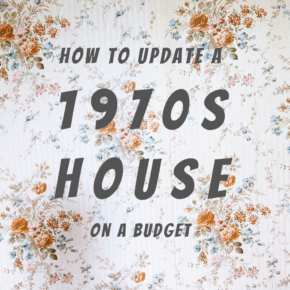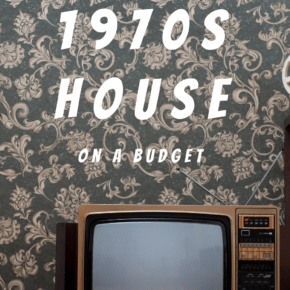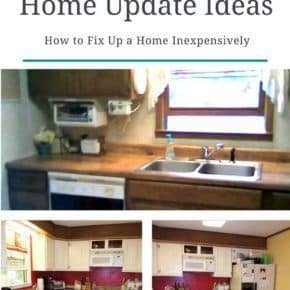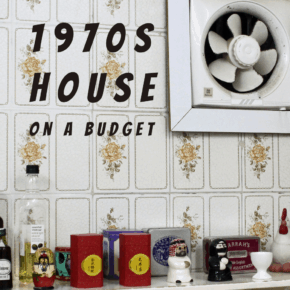Easy Update to Front of House 70's








TV is full of diy home update ideas and entire shows about how to update an old house on a budget. The only thing they don't explain is how to get motivated to do the work. And this begs the question we asked when we wanted to sell our 1970s house: Why isn't home improvement a priority until it's time to move?
I mean, why do people put off home renovations and "honey-dos" until it's time to put it on the market?
- If it's merely a matter of money, why is it important enough to lay out cash to modernize for others but not important enough to spend our money on ourselves? Especially since sites like Credible offer great rates on home improvement loans.
- If time is the issue, how could we suddenly find a way to fit it into our schedules, while we couldn't find the time before?
- If it's a matter of finding the energy, where did we get it, if we didn't have any before?
I don't have an answer to that, to be honest. We were as guilty of putting off our To-Do list as the next person. Okay, we did some minor home renovation along the way, but even though we talked about it a lot, most of the home update ideas were just talk.
We did plenty of reading about every possible to make a house look attractive to buyers … and watched more episodes of Design on a Dime than we probably needed to. Problem was, we put the actual action on the back burner for ages.
Knocking out walls? Only a "someday" idea until we decided to move overseas where life was cheaper. We thought it would create a lot of upheaval and interruptions to our lives. It did, but not as much as we'd expected. For sure, it was worth it in the end.
And yeah, we needed to sell, because the bank was breathing down our necks. Yet there was no way we could sell our old house "as is." Especially in a soft real estate market.
Setting a goal
Moving overseas to save money was a good incentive, but setting a target date was better. We told friends that we were moving to Bali so we would have to do it.
It didn't matter that someone else would enjoy the fruits of our labors. We would enjoy something even better: A new life in a new place.
Talk is all well and good, but … If not now, when?
There's nothing like setting a goal to get you moving. We focused on Our Expat Adventure and it really helped to motivate us.
ⓘ UPDATE: After 10 years of living on another continent, we couldn't be happier. Life is slower and cheaper overseas and the medical care is just as good.
Home improvement, baby steps style
Those magazine home updates are fabulous – until you see the price tag. Ouch! Certainly out of our budget. But here's the thing: A big chunk of the cost comes in the actual building materials.
Here's the good news: You don't feel the pinch as much if you buy things bit by bit.
ⓘ TIP: To save money, borrow power tools from generous friends. Who knows, they might even offer to help!
We kept our eyes open for sales at the big box stores and scoured the bargain racks at Wal-Mart, buying what we knew we would need down the road. So what if we didn't have time to do it? That is a great way to avoid a serious dent in the checkbook. Besides, doing it that way made paying for our home update project a lot less daunting. Practically painless, even.
Here is a brief account of how we changed our split-level 70's house since we first moved in. I originally wrote it to journal what we did along the way, but now that it's finished, hopefully it will give you a few ideas of your own.
We bought most items at Lowe's and Home Depot. You'll find links to Amazon products in this article for your information and convenience.
ⓘ
Save these ideas for improving a 1970s house for later
Add it to Pinterest and share it on Facebook.
4 easy 1970s living room update ideas
For what it's worth, that Home Improvement for Dummies book is pretty useful.
1. Wall color.
Purchased: one 5-gallon bucket each of interior wall paint + matching tinted primer in a bright, cheery color + painting supplies.
Go ahead and roll your eyes. Our living room was "blessed" with that dark, fake-wood wall paneling that every 1970s house seemed to have. What was just as bad: The dining room was an ugly, faded mint green. Omigosh, it felt like we were in a hospital!
It's amazing what a little bit of paint can do—and yes, we were lazy. We primed/painted right over everything, even though the previous owners were heavy smokers. But it worked, and it made the dining and living rooms feel like they were covered in sunshine, so we carried the color down the hall and into the foyer.
Great for us, but with 20/20 hindsight, we should have gone with something a little more neutral, like grey or sand. I'm not sure how many buyers might have been turned off by our Harvester Gold walls.
ⓘ TIP: Buy all your paint at once to ensure that the color will be consistent. One 5-gallon bucket should be more than enough.
2. Bright white trim.
Purchased: One quart of white, semi-gloss latex enamel + paint brush.
Painting baseboards, doors and trim freshened everything up and masked a lot of dings and dents.
- Cost: $20 for a quart of high-quality, bright white paint.
3. New laminate flooring
Purchased: Wood-look laminate flooring, which has a low cost per square foot. We got the kind that "floats" and doesn't require glue. It's easier to install on uneven subfloors.
When we moved in, the carpet was so worn and ugly that we ripped it out right away. It's a good thing we did: The previous owner had been suffering from respiratory problems and powdery mold was hiding underneath the padding.
We lived with raw sub-flooring until we could afford to buy the flooring.
As for labor, tearing out carpets is quick and easy, not to mention fun enough that your kids would beg to do it. The tack strips were just as easy, only needing the claw side of a hammer to remove.
- Disposal: Free. We rolled everything up and hauled it to the dump in the trunk of our car.
If you have a power saw, laminate flooring is easy to install. However, we did hire a pro friend to do the more difficult parts at the end, such as around the sliding glass door.
- Cost for his labor: about $350.
ⓘ TIP: Mold inspector's advice: Sweep up what you can, then spray the floor with hydrogen peroxide. That's the bubbly stuff that people use on cuts.
4. New, modern ceiling fan with light
Purchased: A new ceiling fan for the living room. It has a light, remote control and multiple speeds.
Our living room fan had been installed in the 1970s. It was dated, broken, and noisy. As our son was working toward his Eagle Scout rank in Boy Scouts, we asked a friend to show him how to wire it.
Bonus: it was free labor.
- Cost: about $150.
6 ideas for a 1970s kitchen remodel
Here are a few more ideas for you, if you're looking for ways to update a 70s kitchen on a budget.
5. New wall color.
The day we moved in, we pulled off the kitchen's original, faded floral wallpaper.
With one tug. Yikes.
After sanding the walls, we painted the kitchen walls with some of the living room's paint.
- Cost: You can buy a package of sandpaper in assorted grits for about $15. A kit of painting supplies is less than $20.
6. Accent color
The under-cabinet walls behind the stove and sink got a pop of color. We skipped the primer because we'd just painted the room.
Cleanup took more time than the painting itself.
- Cost: $12 for a quart of bright red paint.
7. White trim.
Purchased: One quart of white, semi-gloss latex enamel + paint brush.
We painted the windows, trim and baseboards in both the kitchen and living room at the same time.
This might have been the easiest home improvement project of them all. It only took an hour, including cleanup. Easy, peasy.
- Cost: Same $20 quart we used for #2, above.
8. New cabinet color and hardware.
Wrought iron hardware is incredibly old-fashioned, and dark wood can make small rooms feel dismal. We removed all the old hardware, plugged the holes with a tube of wood filler, and painted the cabinets vanilla white. This instantly brightened everything up and made the kitchen feel much cleaner.
The cabinet doors had finger pulls, so we didn't need new hardware. The hardest part was removing the doors. Sure, it's more convenient to simply paint over the hinges, but the end result made us glad we didn't.
This old home improvement took up most of the weekend. However, that was mostly because we had to wait for the filler and paint to dry.
- Cost: about $50 for paint and wood filler.
9. New counter top.
Goodbye, Formica burn marks! We replaced the worn countertop with a stock one from Lowe's in a neutral, granite pattern. Conveniently, they even sell ones that are conveniently precut to fit corners.
The big challenge was getting a smooth cut along the wall edge, but we managed okay with a couple of tips from friends. (You can see it in the photo from the demolition phase.)
It took about a day.
- Cost: About $200.
10. New faucet.
You can't replace the kitchen counter without removing the kitchen sink and disconnecting the faucet. Perfect time for a new, updated faucet!
We bought a fantastic faucet with a pull-down sprayer. It offered a high arch to create better sink clearance and created more space while doing the dishes.
- Cost: About $80
11. New window treatments.
A colorful window valance, hung high to admit more light, added some personality and warmth. The red stripe matched the wall.
We also installed an inexpensive white mini-blind for privacy.
- Cost: About $25.
Updating a 70s kitchen (phase 2)
This happened a few years later, when we decided to move. It was well overdue.
12. New open floor plan.
We tore out two kitchen walls ourselves. I'll admit, it was more fun than it probably should have been.
13. Glazed cabinets.
We antiqued the vanilla colored cabinets with a warm brown glazing paint (Sherwin Williams French Roast). It hid a lot of our painting imperfections and gave the cabinets a high-end look. Gorgeous!
Had I realized it would only take a couple of hours (not counting drying time) I'd have done it ages ago. Omigosh, that was too easy for words, and the result was stunning!
I'm sorry to say the photos were lost.
As a matter of fact, glazing was so fun and easy that while I was at it, I decided to glaze the cheap fake-wood medicine cabinets and sinks in both bathrooms too. They sure don't look ancient and beat up now!
14. New hardware.
I also added the cheapest brushed-nickel hardware I could find. The key was to get something that fit the existing holes.
It's amazing how such a small expense can change the entire feeling in a room. That little bit of bling? #worththeeffort
- Cost: less than $100.
15. New kitchen island with breakfast bar.
This took the most planning, because we wanted to install it right over the area where the kitchen wall had been. Okay, the real reason was that we didn't want to rip up our newly installed flooring.
When Home Depot changed their models, we bought the closeouts and adjusted our design for the cabinets that were available. The finish was different to the wall cabinets, but that's common these days. No reason for painting and glazing to match.
Remember the Formica counter top we had installed in Phase 1? It was a standard, stock color, so we bought the same style for the island. Using the same style throughout tied the entire kitchen together into one cohesive whole.
A carpenter laminated the new breakfast bar with matching sheets of Formica. (You can find them right next to the ready-made countertops.)
16. New lighting.
Goodbye, fluorescent fixtures! Removing the overhead fluorescent created a hole in the ceiling. Patching, then painting the ceiling was next.
We added a few well-placed dimmable can lights. as well as two pendants over the breakfast bar on a different switch.
To save money, we hired a friend in the home improvement business and acted as his go-fer so he didn't have to pay an assistant.
17. New kitchen appliances.
The appliances took a huge bite out of our finances but it was so worth it! To economize, we bought floor models from the scratch-and-dent area of the big box store, one by one.
We stuck to a black finish to ensure everything would match.
Updating a 70s bathroom
Avocado. What were they thinking in the '70s? Our master bath was so horrendous I knew it would turn off buyers. All the elbow grease in the world would never make this old bathroom look clean.
We had no choice but to switch out everything, from top to bottom. We paid the sanitation department to deliver a dumpster, and out it went.
- Cost: Under $2000 for everything we did to the bathroom.
18. Paint the walls
After 30 years, walls can look really dingy. One quart of latex enamel = brighter walls (a vanilla-eggshell hue).
White, gloss latex enamel for the trim, window and door. Same quart we'd used in the kitchen and living room.
19. Replace the tub
The original tub and shower was a one-piece plastic deal. It and the glass sliding door had two things against them: major hard-water buildup, and 1970s avocado ugliness.
In went a new, inexpensive bathtub and a curved shower rod. While it cost a bit more than a straight one does, we'd stayed in a hotel that had it and liked the extra elbow room it offers.
20. Replace the floor.
No more peel-and-stick vinyl tiles. Instead: the cheapest 12″ floor tiles that we could find in a neutral color. Again, we bought them when the store was running a sale.
Also, we replaced the baseboard and painted it with the trim paint. One 6-foot piece was more than enough.
It helps to have friends in the renovation business. We borrowed a tile saw and installed the floor ourselves. That said, we know our limitations. When the time came to tile the walls, we paid a professional to do it.
I'm sorry I only have this one shot from midway thru the bath renovation. Trust me: Replacing the ugly toilet and tub surround in the master bath brought our bath into the 21st century. Long overdue.
21. Tile the walls.
We've long liked the upscale look of travertine tile. So when Habitat for Humanity's ReStore (salvaged goods shop) had some boxes of damaged tiles, we bought them all. There were just enough to use in the shower/tub area.
Two splurges: a travertine soap dish and a narrow strip of 1″ glass tiles, which we bought at the hardware store. The glass tiles were an accent at eye level above the tub. Who knows … little touches like those might be the tipping point with buyers.
22. Replace the toilet
Once the tub was in, it was time for a new toilet. In white. The seat was at a more comfortable height than the old one had been. Before, it had felt like we were squatting.
If you're considering this, you'll be pleased to know that newer commodes are designed to be more water efficient. Another money saver!
ⓘ TIP: A toilet riser is an affordable way to raise a commode up to a more comfortable height.
23. New sink and cabinet
The original 1970s bathroom sink was stained and badly chipped, the faucet was corroded, and the cabinet was an odd size. We scored a 30″ sink-cabinet combo for under $300 when there was a sale at Lowe's.
24. New medicine cabinet
The mirror on our original medicine cabinet had spots that were missing the silver backing, and the interior was damaged from toiletry leaks.
Our home improvement store has a section where they sell slightly damaged goods at a discount. One day, we found a mirrored medicine cabinet that was oversized enough to cover the hole from the old cabinet. Win!
Master bedroom easy makeover
25. Painting bedroom walls
I know. Again with the paint. We detested the dark paneling in the master bedroom from the moment we first looked at the house. And yet, we never did anything about it. Until now.
To save money, we used the same 5-gallon bucket of Harvester Gold paint that we bought when we first moved in. Despite the fact that buyers might not like the color, I'm sure they would prefer anything over nicotine-stained 1970s wood paneling.
Want to read this later? Save it to Pinterest!
Source: https://www.aswesawit.com/home-improvement/

0 Response to "Easy Update to Front of House 70's"
Post a Comment